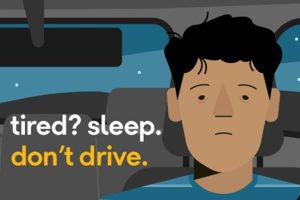
GLEN BURNIE, MD (November 4, 2022) – We’ve all been there – yawning and feeling tired during a long car ride or after a busy day at work. These are the beginning signs of drowsy driving, which can impact thinking, decision-making and alertness. While there is no exact measure of drowsy driving, research indicates it is dangerously common. Governor Larry Hogan and the Maryland Department of Transportation Motor Vehicle Administration’s (MDOT MVA) Highway Safety Office, with the National Sleep Foundation (NSF), is recognizing November 6-13 as Drowsy Driving Prevention Week ® to bring awareness to this troubling trend. Read the Drowsy Driving Prevention Week Proclamation here.
Drowsy Driving Prevention Week ® is a time to educate drivers on warning signs and the practices that can cause drowsiness, as well as the consequences of drowsy driving. Drowsy driving is considered to be underreported since it relies mostly on police and hospital reports. Nevertheless, in Maryland during the past five years nearly 5,000 people have been injured and 55 people have been killed due to drowsy driving.
“We hope highlighting the dangers and consequences of drowsy driving will educate Marylanders so they can avoid this unnecessary risk,” said Governor Hogan. “Maryland is committed to achieving zero deaths on our highways, and that requires that motorists make the choice to drive alert, sober and focused.”
According to new NSF data, 37 million motorists are estimated to drive drowsy at least once per year. While falling asleep at the wheel is incredibly dangerous, even driving while sleepy slows your reaction time, affects your ability to make good decisions and takes your full attention away from the road. These effects are similar to impairment. According to the NSF, a clinical trial found that being awake for 17 to 19 hours is comparable to having a blood alcohol content of 0.05%, leading to decreased reaction time and reduced hand-eye coordination. Longer periods without sleep could produce results equivalent at BAC of 0.1%.
Drowsy driving is preventable – just like other factors that contribute to crashes. To help educate the public, MDOT MVA’s Highway Safety Office has again expanded its all-encompassing Be the Driver campaign to now include Be the Alert Driver, reminding motorists of the importance of being well-rested and alert before getting behind the wheel.
“Drowsy driving is a relatable experience and a public health issue that can affect everyone. NSF commends Maryland for its commitment to sleep health and road safety, and we encourage all drivers to sleep first and drive alert,” said John Lopos, NSF CEO.
NSF provides three key steps motorists should take before driving that can help prevent falling asleep behind the wheel:
- Get the recommended amount of sleep the night before your trip (7 to 9 hours for most adults),
- Plan long trips with a companion, and
- Schedule regular stops every 100 miles, or every two hours.
A large factor in preventing drowsy driving crashes is recognizing the causes and warning signs. If you start to display signs of heavy eyelids, frequent yawning, drifting lanes, hitting rumble strips or missing signs or exits, pull over immediately to a safe and legal location and do not resume driving until you are alert. It’s also important to check any medications for side effects.
Learn more about the MDOT MVA’s Highway Safety Office’s commitment to zero deaths on Maryland roadways at ZeroDeathsMD.gov and on Facebook, Twitter and Instagram at zerodeathsmd.
About the National Sleep Foundation
National Sleep Foundation is a 501(c)3 nonprofit corporation dedicated to improving health and well-being through sleep education and advocacy. Founded in 1990, the NSF is committed to advancing excellence in sleep health theory, research and practice. More information about being your Best Slept Self® and how to help prevent drowsy driving is available at theNSF.org.
theNSF.org │SleepHealthJournal.org
###